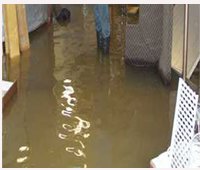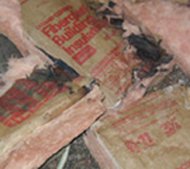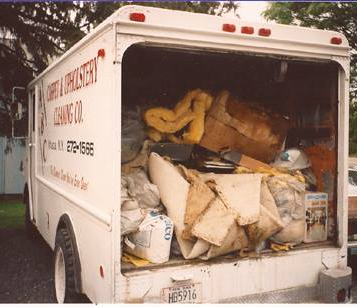Flood Damage Remediation
Proper flood damage remediation is essential to prevent mold and mildew growth. Floods are a major cause of mold and mildew growth. Mold and mildew will begin to develop within 24 to 48 hours of any water exposure in the home, including leaks, sewage back-up, overflows, etc. Mold and mildew will continue to grow until the source of the moisture is dealt with.
Immediate Steps to Take for Flood Damage Remediation
- 1. Call your insurance company to see if the damage will be covered. Some policies require extra insurance if you are in a flood zone.
- 2. Call a flood damage remediation company immediately in the case of water intrusion. Doing this as soon as possible after you notice any water damage can make the difference between a relatively short job and a much longer, costlier one. Water damage must be caught within hours in order to prevent sheetrock damage and carpet and pad replacement. Affected areas can be dried with extraction, dehumidification equipment, and engineering controls before mold has a chance to take over.
- 3. The following questions should be answered to ascertain whether or not mold and mildew have had a chance to start (which leads to different skills and services). The answers to these questions will also help the water damage restoration technician decide what equipment needs to be brought to the site.
- The location of the water damage.
- The extent of the damage.
- The source of the water.
- Whether or not the water flow has been stopped.
- The size of the area affected.
Additional questions which help determine the degree of drying required:
- What exactly happened?
- When did the intrusion occur?
- Has this happened before? If so, was it professionally remediated?
- What are the walls made of?
What to Expect from the Flood Damage Remediation Professional
Once the proper information is obtained, Flood Damage Remediation Technicians will come to the site to take hygrometer readings, both inside and outside the home or business. A moisture meter, penetrating or non-penetrating, will also be used to determine the severity of the damage. That way it can be determined which parts of the building are wet and also how deep the water level goes. These sensors can also help to see if water has stopped in the main affected area or gone under the wall into the next room.
If water needs to be removed, the professional Flood Damage Remediation Technician will come prepared to do everything necessary to remove it. Sometimes this may mean drilling a hole into the ceiling or an otherwise restricted space to let the water out and allow air to flow.
Before any water extraction begins, the customer should be told of the extent of the damage, the types of equipment to be used, and the length of time the operation might take. The customer should be given an opportunity to ask any questions and voice any concerns.
If an insurance adjuster is involved, the professional Flood Damage Remediation Company should be happy to work with the adjuster to speed the completion of the job and return your home or business to its proper state.
The Water Damage Remediation Procedure
Removal of Affected Objects and Water
If furniture or other objects must be removed, this will be done first. Free-standing or running water will be removed from the surfaces of any affected items. After the contents are removed and protected, extraction of water will begin.
Water Extraction
Depending on the size of the water intrusion, equipment ranging from portable extraction units to heavy-duty truckmounted units will be used. The attempt will be made to remove as much water as possible from the area. Standing water will be removed first and then water will be removed from carpeting and pads.
Please note: If flooding is widespread and a representative of a Flood Damage Remediation Company representative cannot get to you quickly, your local fire department may be prepared to extract standing water until actual remediation takes place. A carpet cleaning company should also be able to extract a majority of the water. Many carpet cleaning companies are also certified as water damage remediation contractors.
Special Equipment
Air-movers
Air movers are special units that blow air with tremendous pressure across a surface to help it to dry out faster. An air mover will pick up moisture from the surface and the more air you can pass over the surface, the more rapid the drying.
Dehumidifiers
The drier the air, the sooner the entire area will dry. Dehumidifiers pull the moisture from the air. What type of dehumidifier used (refrigerant or desiccant) will depend on the scope of the job. Refrigerant dehumidifiers can pull moisture at temperatures as low as 35 degrees F. Desiccant dehumidifiers are used in specific instances beyond the use of refrigerant dehumidifiers.
Monitoring and Metering
During the entire process of drying, the area must be continually monitored by the Flood Damage Remediation Company and the drying progress checked with meters. The drying equipment will have to be moved around to take full advantage of their capabilities.
Drying time can vary depending upon the density of the building material. Sheetrock dries out relatively quickly while wooden studs take longer. Plaster and concrete and any porous materials take the longest time to dry.
Carpets, pads, upholstery, and insulation in wall cavities and under floors can all absorb vast amounts of moisture. Surfaces with vapor barriers can be very hard to dry if the moisture is able to seep under the surface. Vinyl floors in kitchens and bathrooms sometimes need to be torn up in order to let air flow freely to the wet areas.
Proper drying techniques, properly trained Flood Damage Remediation Technicians, and state-of-the-art and well-maintained equipment, combined with the use of EPA registered disinfectants and anti-microbials can transform your water-damaged areas to spaces that are environmentally safe and habitable within hours of the initial onset.
How to Clean and Disinfect Contaminated Areas Without the Help of a Professional
As a general rule, if there has been a large amount of water damage and/or the mold growth covers more than 10 square feet (less than roughly a 3’x3’ patch), you probably will not be able to handle the job without professional intervention.
It is important to be very mindful that molds are always a source for health problems, especially when the airborne mold spores are inhaled in large quantities. Infants, children, immune-compromised patients, as well as pregnant women, the elderly, and those with existing respiratory conditions are actually at a higher risk for adverse health effects.
Some symptoms that can occur from exposure to mold include:
- Respiratory problems such as wheezing and asthma attacks
- Nasal and sinus congestion
- Dry, hacking cough
- Burning, watery and red eyes
- Nose or throat irritation causing sneezing fits or bloody noses
- Skin irritations such as rashes or hives
- Headaches, memory loss and mood changes
- General aches and pains
Of Special Concern: Black Mold
Toxic black mold, Stachybotrys atra, a greenish-black, slimy mold resembling tar or black paint can cause much more serious health problems. In the case of the presence of more severe mold infestations, especially those with black mold, it would be better to call on a mold remediation professional. In any case, when exposed to mold, it is advisable, especially for sensitive people, to wear tight fitting masks or respirators.
Because of the health-related issues and the unfamiliarity most consumers have with mold issues, ABC suggests calling a certified mold removal firm to eliminate any moderate to severe mold problems.
Be Prepared Before Cleaning
If you still wish to do the work yourself, make sure you wear gloves, a mask, and some form of eye protection. Also make sure the working area is well-ventilated.
Cleaning must be done before disinfection can begin.
Special Precautionary Measures to Take
Make sure to exercise extreme caution when cleaning and disinfecting molds because mold spores will be released when the mold is disturbed.
NEVER EVER MIX BLEACH WITH AMMONIA. The fumes can kill you.
Be careful how and where you discard items that have been mold-contaminated. A professional trash handler may be needed for this task.
Cleaning Hard Surfaces
For hard surfaces, wash non-porous materials with a non-ammonia detergent and hot water. For rough surface materials, such as concrete, rub with a stiff brush.
After disinfecting all cleaned surfaces with a 10% bleach solution, let the solution stay on the surface for at least 10 minutes and then rinse with clear water and allow to dry.
Please note: The bleach solution will kill the mold but not necessarily the spores.
Cleaning Porous Materials
Do not attempt to clean porous materials such as upholstered furniture, rugs, clothing, books, papers, etc., if the item has been wet for more than 48 hours.
If less than 48 hours has gone by, wet porous materials can be cleaned and disinfected with a pine-oil cleaner. After an item is dry, monitor it for several days for any new mold growth and odors. If mold does develop, discard the item.
DRY, DRY, DRY!
A wet or contaminated area must be allowed to dry completely, at least 2 to 3 days, before rebuilding, replacing or returning any items to the area.
Need More Advice?
Though ABC no longer performs water damage restoration or mold remediation, we would be happy to answer questions you may have regarding these issues.
You can call or text us at 607-272-1566 or Contact Us here.
Top of Flood Damage Remediation
Back to Homepage
"The Cleanest Clean You've Ever Seen."
by
ABC Oriental Rug & Carpet Cleaning Co.
130 Cecil Malone Drive Ithaca, NY 14850
607-272-1566




